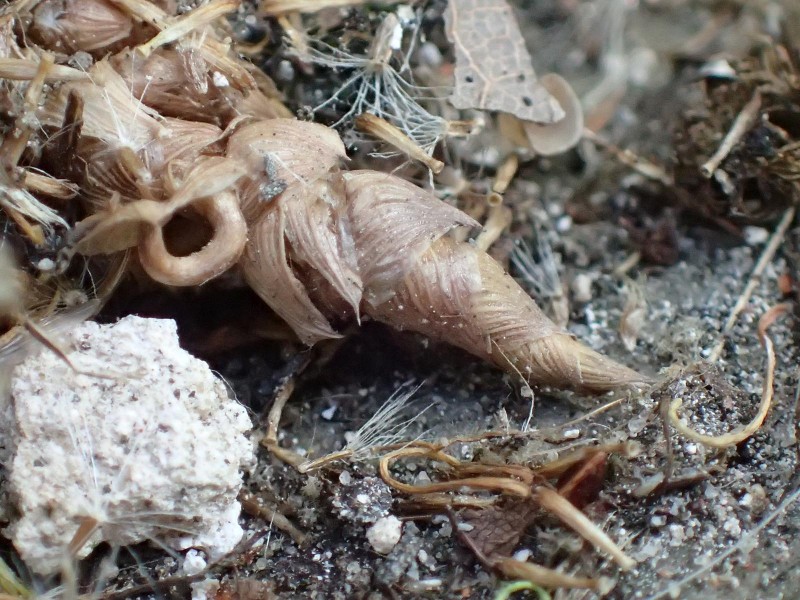Muhlenbergia mexicana (L.) Trin. (syn.: Agrostis mexicana L.) (N-Am.) – A very rare but increasing alien. Formerly, around 1825, cultivated as a fodder grass in the Vesdre valley near Verviers and locally reported as an escape in the 19th century (long gone by now). Found in 2005 as a weed in a plantation in Boom. Subsequently seen at several locations in the city of Antwerpen in 2006 and 2007 and as plantation weed at the railway station in Dendermonde in 2008 (Verloove & Hoste 2010). In 2011 furthermore seen by a path in Hamme, apparently introduced with mulch, and in 2016 as an urban weed in the city of Ghent (subsequently regularly confirmed, e.g. in 2018). In 2018 also observed as a plantation weed in Brugge (several dozens).
The origin of these recent records remains obscure. Muhlenbergia mexicana is – although not attractive – cultivated for ornament in Europe (Walters & al. 1984) and might be interpreted as a garden escape (see also Hetzel 2006). This is probably no longer the case: it is, for instance, not cited by Jäger & al. (2008). According to Hetzel & Meierott (1998) occurrences of Muhlenbergia mexicana are associated with garden waste in Germany. Recent Austrian records are also associated with garden centers (Hohla 2011). Most of the recent Belgian records also suggest an introduction through horticulture but probably rather as a weed than as an ornamental. This is in accordance with Rücker (2006) who found out that Muhlenbergia mexicana had been introduced in Germany as a contaminant in Dutch container plants. The species might have been overlooked in Belgium and is possibly locally naturalised in plant nurseries.
Muhlenbergia mexicana is exceedingly similar to another North American species, M. frondosa (Poiret) Fernald (syn.: Agrostis frondosa Poiret). The latter is given for northwestern Europe by Ryves & al. (1996). At least part of these records is also referable to Muhlenbergia mexicana (for instance those from urban areas in Basel, Switserland; pers. obs. author). The two taxa are separated as follows:
- Internodia densely short hairy. Axilllary inflorescences absent === Muhlenbergia mexicana
- Internodia glabrous. Axillary inflorescences usually present === M. frondosa
Reliable European records for Muhlenbergia frondosa are available from, for instance, northern Italy (Abbà 1975; pers. obs. author).

 |
 |
 |
 |
 |
 |
Literature:
Abbà G. (1975) Alcune esotiche nuove o poco note per la Flor a italiana. Inform. Bot. Ital. 7(3): 362-364.
Breitfeld M., Horbach H.-D. & Scholz H. (2011) Bemerkenswerte Funde im Florengebiet Bayreuth und Bad Berneck. Ber. Bay. Bot. Ges. 81: 148-155.
Dickoré W.B., Lewejohann K. & Urner R. (2009) Neufunde, Bestätigungen und Verluste in der Flora von Göttingen (Süd-Niedersachsen). Florist. Rundbriefe 42: 5-59.
Hetzel G. (2006) Die Neophyten Oberfrankens. Floristik, Standortcharacteristik, Vergesellschaftung, Verbreitung, Dynamik. Diplomarbeit, Bayerischen Julius-Maximilians-Universität Würzburg: 156 p.
Hetzel G. & Meierott L. (1998) Zur Anthropochorenflora fränkischer Deponiestandorte. Tuexenia 18: 377-415.
Hohla M. (2011) Cardamine corymbosa (Brassicaceae) und Bromopsis (Bromus) riparia (Poaceae) - neu für Österreich sowie weitere Beiträge zur Adventivflora von Oberösterreich, Niederösterreich und Salzburg. Neilreichia 6: 55-79.
Hohla M. (2012) Bromus sitchensis – neu für Österreich, Plantago coronopus - neu für Oberösterreich sowie weitere Beiträge zur Kenntnis der Flora des Innviertels. Stapfia 97: 180-192.
Jäger E.J., Ebel F., Hanelt P. & Müller G. (eds.) (2008) Rothmaler Band 5. Exkursionsflora von Deutschland. Krautige Zier- und Nutzpflanzen. Springer Verlag, Berlin: 880 p.
Rücker K. (2006) Vorsicht vor Muhlenbergia mexicana! Gartenpraxis 12: 20-21.
Ryves T.B., Clement E.J. & Foster M.C. (1996) Alien grasses of the British Isles. BSBI, London: XX + 181 p.
Scholz H. (2011) Fremdländische Gräser (Poaceae) in Deutschland. Beitrag zur Diskussion biologischer Invasionen. Kochia 5: 1-7.
Verloove F. & Hoste I. (2010) Een nieuw Amerikaans stadsgras in België: Muhlenbergia mexicana. Dumortiera 98: 10-12.
Walters S.M., Brady A., Brickell C.D., Cullen J., Green P.S., Lewis J., Matthews V.A., Webb D.A., Yeo P.F. & Alexander J.C.M. (eds.) (1984) The European Garden Flora, vol. 2 (part II). Cambridge University Press: 318 p.

